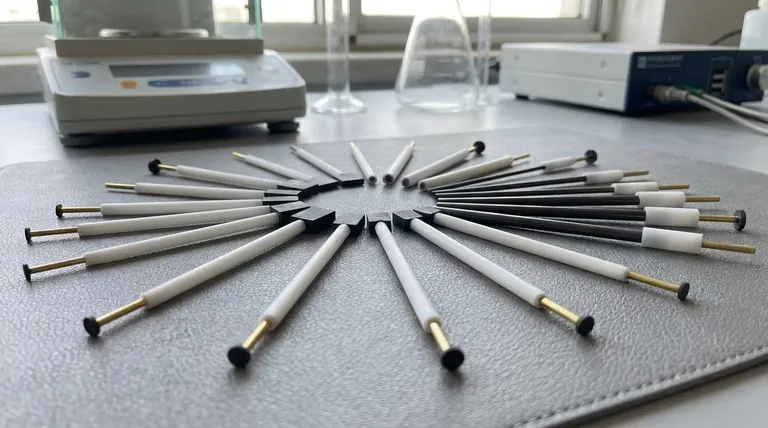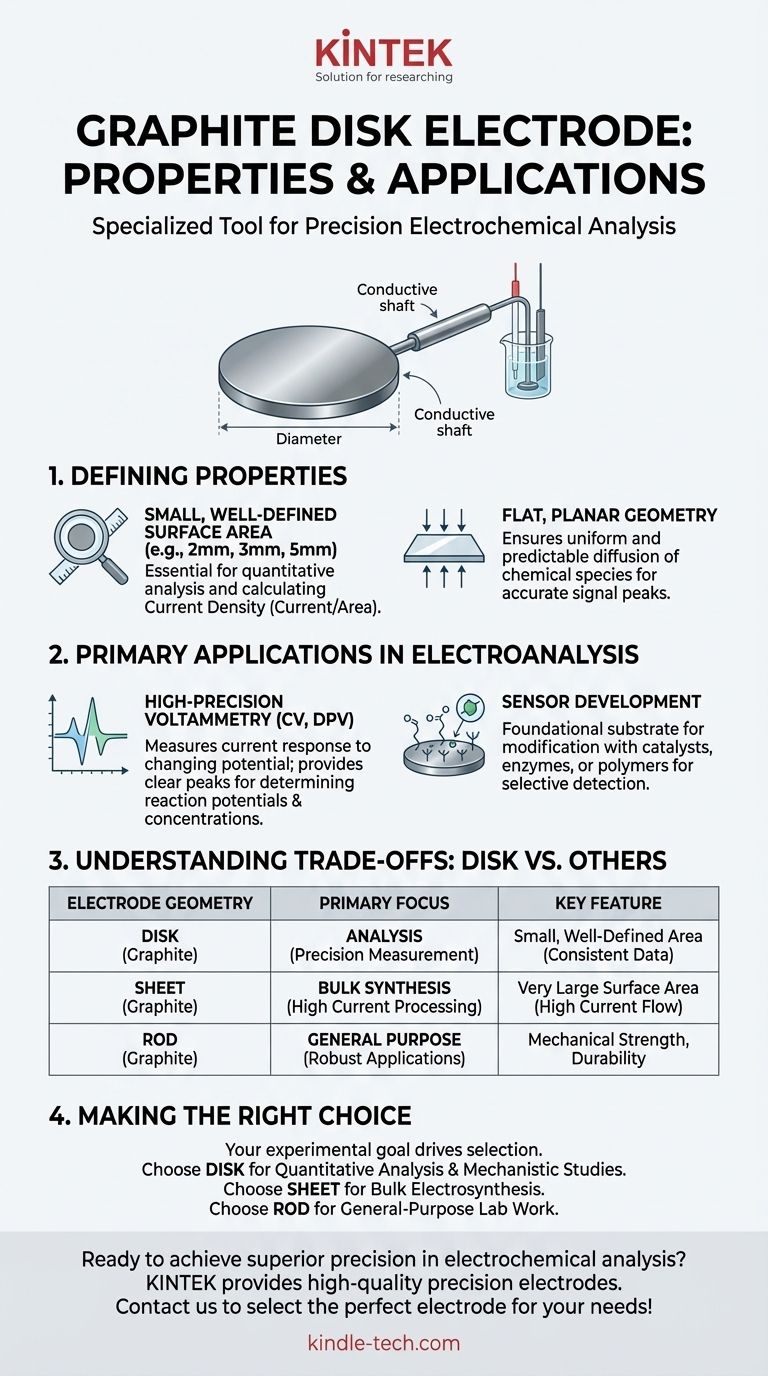In essence, a graphite disk electrode is a specialized tool for precision. It is defined by its small, flat, circular surface, a design that makes it exceptionally well-suited for high-precision electrochemical analysis techniques like cyclic voltammetry and differential pulse voltammetry.
The core principle to understand is that an electrode's geometry directly dictates its function. The graphite disk electrode is engineered for analytical measurement, where a controlled, well-defined surface area is paramount for obtaining accurate and reproducible data.

The Defining Properties of a Graphite Disk Electrode
The value of a graphite disk electrode comes from its specific physical form, which enables a class of sensitive electrochemical measurements.
A Small, Well-Defined Surface Area
The electrode's most critical feature is its known and consistent surface area, typically with diameters of 2mm, 3mm, or 5mm.
This fixed area is essential for quantitative analysis, as it allows researchers to accurately calculate current density (current per unit area), a fundamental parameter in electrochemistry.
Flat, Planar Geometry
The perfectly flat surface ensures that the diffusion of chemical species to the electrode is uniform and predictable.
This predictable diffusion is a prerequisite for interpreting the results of many analytical techniques, where the shape and position of signal peaks depend on mass transport to the electrode surface.
Primary Applications in Electroanalysis
The unique properties of the disk electrode make it the standard choice for experiments focused on understanding and quantifying electrochemical reactions, not for creating large amounts of product.
High-Precision Voltammetry
It is the workhorse for techniques like cyclic voltammetry (CV) and differential pulse voltammetry (DPV).
In these methods, the goal is to measure the current response to a changing potential. The disk's small, defined area provides clear, sharp peaks that can be used to determine reaction potentials and analyte concentrations.
Sensor Development
The disk often serves as a foundational substrate for building chemical and biological sensors.
Its flat surface is ideal for modification with specific catalysts, enzymes, or polymers that can selectively react with a target molecule, producing a measurable electrical signal.
Understanding the Trade-offs: Disk vs. Other Geometries
Choosing the right electrode means understanding what a disk electrode is not designed for. The decision almost always comes down to precision measurement versus bulk processing.
Disk vs. Sheet Electrodes
A graphite sheet offers a very large surface area. It is designed for applications that require high current flow to process large volumes of material.
The disk electrode is for analysis; the sheet electrode is for bulk synthesis or large-scale electrolysis.
Disk vs. Rod Electrodes
A graphite rod is valued for its mechanical strength, simple structure, and ease of use. Its surface area is less defined than a disk's.
The rod is a robust, general-purpose tool for applications like small-scale electrodeposition or corrosion studies, where absolute analytical precision is secondary to durability.
The Limitation of Low Current
The primary trade-off of the disk's small surface is its inability to support high currents. It is unsuitable for any application that requires converting a significant amount of material.
Making the Right Choice for Your Experiment
Your experimental goal should be the sole factor driving your electrode selection.
- If your primary focus is quantitative analysis or mechanistic studies: The graphite disk electrode is the correct choice, as its defined surface provides the necessary precision.
- If your primary focus is bulk electrosynthesis or electrolysis: A graphite sheet electrode is superior because its large surface area supports the required high currents.
- If your primary focus is general-purpose lab work or robust applications like corrosion testing: A simple graphite rod often provides the best balance of performance and durability.
Ultimately, selecting the correct electrode geometry is as critical as choosing the right chemical reagents for your experiment.
Summary Table:
| Property | Application | Key Advantage |
|---|---|---|
| Small, Well-Defined Surface Area | Cyclic Voltammetry (CV) | Accurate current density calculation |
| Flat, Planar Geometry | Differential Pulse Voltammetry (DPV) | Predictable diffusion for clear signal peaks |
| Consistent Surface | Sensor Development | Ideal substrate for functionalization |
Ready to achieve superior precision in your electrochemical analysis?
At KINTEK, we specialize in providing high-quality lab equipment, including precision electrodes tailored for analytical applications. Our graphite disk electrodes are designed to deliver the consistent, reliable performance your research demands, ensuring accurate and reproducible results in techniques like cyclic voltammetry and sensor development.
Let our experts help you select the perfect electrode for your specific experimental needs. Contact us today to discuss how KINTEK can support your laboratory's success!
Visual Guide

Related Products
- Graphite Disc Rod and Sheet Electrode Electrochemical Graphite Electrode
- Rotating Platinum Disk Electrode for Electrochemical Applications
- Metal Disc Electrode Electrochemical Electrode
- Gold Disc Electrode
- RRDE rotating disk (ring disk) electrode / compatible with PINE, Japanese ALS, Swiss Metrohm glassy carbon platinum
People Also Ask
- What is the typical role of a graphite electrode in an electrochemical setup? Complete Your Circuit Efficiently
- Is graphite a conductive metal? Discover Why This Non-Metal Powers Modern Technology
- How should a graphite electrode be cleaned and stored after an experiment? Ensure Reliable Electrochemical Data
- What are graphite grades? Find the Right Material for Your Industrial Application
- What is the thermal conductivity of graphite at room temperature? A Guide to Its Anisotropic Nature



















